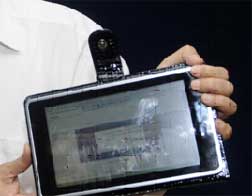|
Sangeetha Sridhar Articles |
Other useful Articles
Computer Main page|
Free weekly downloads|
Twitter |
Printer drivers|
Antivirus |
Children safety |
SMS|
Articles

Prototype of $35 Tablet PC from India
As more
and more power has been packed in to our computers, it is now a ubiquitous
device for most of the population enhancing lifestyles. However its higher
costs inhibit many to own their own personal devices and this is set to
change with the low-cost computing devices surfacing in the market in the
recent times. So itís time for one-to-one computing using the low-cost
computing devices to make a big difference in the developing world.
A low-cost
device could be a low-end pc such as the netbook of tablet pc, which is priced
affordably for common consumption. Considering the need for such devices in
large number say for the purpose of education, has made several indigenous
projects as well as projects reasonably successful.
The recent
launch of the 35$ tablet PC running on Linux-variant platform from India is
certainly a milestone in this direction. For the mere cost of 1500Rs, one can
get a touch-screen device that is Web-enabled with built-in browser and video
conferencing capabilities. Lack of internal memory is altered with memory
card-based storage slot and it can run on solar-power if necessary.
Considering some of the features
commonly expected in such low-cost devices the following emerge on top:
∑
Power consumption
and alternative sources
∑
Portability and
durability
∑
Simplicity in
interface including touch-screen capabilities
∑
Alternate mean of
storage including flash or card-based memory
The Indiaís tablet PC prototype
seems to be a best fit in all the above features. The next phase will see
industry coming forward to manufacture this prototype in large number and
project management for distribution via suitable channels to the educational
sector and the low-income communities. Having said that Indiaís existing
Internet infrastructure is making leaps and such connectivity through low-cost
devices is expected to make a significant economic impact in the long run.
Earlier MIT
had pioneered the XO-1 laptop was developed by the One Laptop per Child (OLPC)
trade association in a move toward equipping each child with 1 laptop. Along
with the backup of the UNDP the large scale roll-out of this laptop was
considered for execution in several countries including Argentina, Brazil,
China, Egypt, Libya, Nigeria, and Thailand.
Here are a
few other initiatives from around the world to promote the development of
low-cost computing devices. Note that most are either linked-to or funded by
government sponsors and target developing countries.
∑
Longmeng (Dragon
Dream) by the Institute of Computing Technology, China
∑
Programa miPC,
Argentina
∑
PC Conectado &
Computador Para Todos, Brazil
∑
Gyanotkarsh,
Gyanjyoti of India
∑
PC Gemilang, from
Malaysia
∑
Computers for All
Nigerians Initiative (CANi) of Nigeria
∑
Peopleís PC
Program in Philippines & Thailand
∑
Saudi Arabian Home
Computing Initiative
Considering such light-weight
front-end devices, the future of computing seems to be based on Cloud Computing.
The concept of cloud computing is about pooling
resources, software, and information in clouds and accessing these through the
Internet via thin-client machines (including the Internet-enabled devices).
In reality the basic mobile phones,
growing with smart capabilities are the true low-cost devices that masses can
afford and adopt instantly. However their screen size, resolutions and energy
constraints give in room for hand-held devices like pads or tablets to grow in
the market.
The infrastructure based on Cloud
sources eliminates the need for high powered client devices and there by
connectivity and user-friendly interface are adequate for workforce as well as
common users. The proliferation of low-cost computing devices will further the
concept of computing on the go and free the workforce from their need to be
tethered to physical workstations at physical office locations.
The author is a technology
evangelist working as consultant at the Information Technology Authority of Oman
and can be contacted at
sendsangita@gmail.com or
http://digitaloman.blogspot.com or
http://twitter.com/sangitasri
| 



